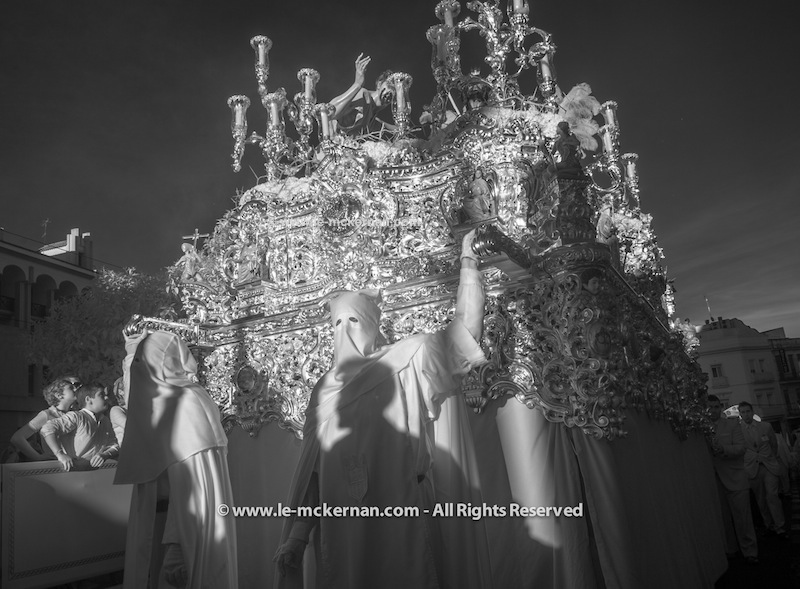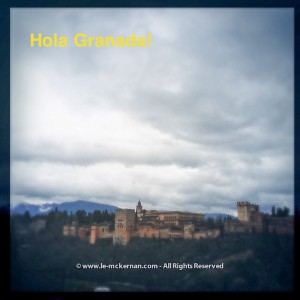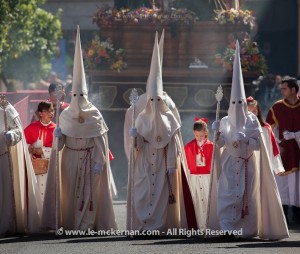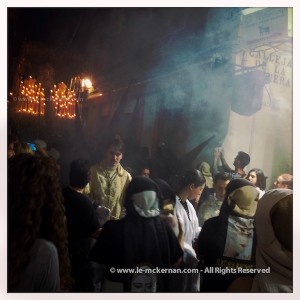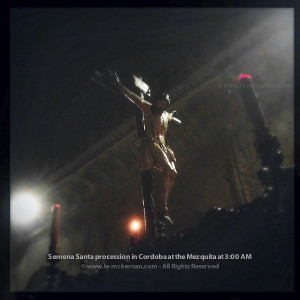Travel Blog — a month in Spain . . . .
– March 2015 –
Cordoba has long been on my travel bucket list. Unfortunately, the ordeal of a painful international hop-scotch to Andalucia from Hong Kong (via London and then to Barcelona followed by a 5-hour train ride to Cordoba) made this journey logistically infeasible. Thus, Cordoba remained a dream . . . until now — I’ve recently moved back to London and with Spain in my backyard, I am writing this blog from Cordoba!
And my first impression? Sadly, it was not positive at all! Thankfully, first impressions are only just that because my enjoyment of the city markedly improved once I got beyond the first few humps.
My first sight of the city was marred with overfilling rubbish bins and garbage strewned all over the platform at the train station. This was particularly surprising because we’d arrived a few days before the start of Semana Santa (Easter Holy Week) and this was a major event for the city. Although one could attribute this to the ongoing period of deep austerity, I did not see this amount of filth (if at all) in Barcelona, Sevilla and Granada. Prior to arriving in Cordoba, my husband and I spent many wonderful weeks meandering around the aforementioned cities and they were generally spotless.
The bigger surprise, however, was the complete lack of interest and the unhelpfulness we received at the Informacion Turistica reception! We went to the main tourist office near the Mezquita and asked one of the ladies behind the information counter for the Semana Santa procession schedule and routes. This lady, aka “The Unhelpful Cordoba Tourist Officer” told us that she did not have this information. When we’d asked where we could get this information, she told us that the schedule and routes have not yet been set and therefore was not available. This jarred with us because we could clearly see that the council had already started setting up stands along the streets. As such, we ignored the misinformation from the tourist office and went online. Using the link (http://english.turismodecordoba.org/seccion/holy-week) provided to us by our AirBnB host, we mapped out procession routes and timetable ourselves.

Negative first impressions aside, I must confess that I did truly enjoy Cordoba (and Spain) very much. The two issues mentioned above were minor irritants and minuscule compared to the mountain of wonderful food, impressive sights and warm charm of the people and country.
As alluded to earlier, main purpose of this trip was to see the Semana Santa processions in Cordoba. But, rather than do this as a fly-by-visit, we wanted to take our time and explore the key cities. To have a more authentic experience, we’d opted to avoid hotels altogether and use AirBnB accommodations situated in the centre of each city. In all but 1 apartment, we had a private kitchen. This enabled us to cook regional dishes using local produce from nearby markets. To get around, we’d expressly forbade ourselves from taking taxis (unless we had luggage and were in transit to/from the train stations). Whenever and wherever possible, our primary mode of transportation in each city was by walking.
Our slow-and-explore approach meant that we’d spent 7 nights in Barcelona (6 nights at the start of the trip and then 1 night before flying back to London), 5 nights in Sevilla, 6 nights in Granada and 12 nights in Cordoba.
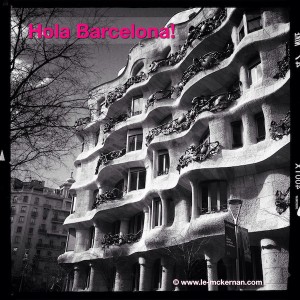
Like Cordoba, Barcelona was also on my bucket list for a long time. I had visions of Gaudi and Dali exploding in urban technicolor; as a photographer, I was chomping at the chance to capture the magic of Barcelona in infra-red. Unfortunately, the sites that I was most keen to photograph were defaced with construction cranes (at the Sagrada Familia cathedral) or with wire fences (at the rooftop of the Pedrera). Paradoxically, these eyesores were actually beneficial as they forced me to find creative angles and be inventive with my composition.
In truth, whilst I’d enjoyed photographing Barcelona, I actually enjoyed my time there more with my Nikons inside my bag. My favourite moments in Barca centered around food. We decided to forgo recommendations from the ubiquitous travel books and blogs and instead use our instincts to select places to drink and eat. I’m happy to report that we did not have one bad meal! We had traditional Catalan food (such as fideua), traditional tapas, churros con chocolate, fresh seafood from the markets, gastropub food, and a few funky artisan dishes. The standout funky dish was ‘baby sardines on filo pastry with caramelised onions … and whipped cream‘. Although this sounded deeply weird, the combination worked — the tastebuds were very happy!!! And other standout dish was veal with ‘cuttlefish noodles’ — the chef shaved the cuttlefish so thinly that the flesh curled like tagliatelle noodles! Surprisingly, however, the dish that I remembered most fondly (and plan to make often at home) was actually the simplest dish we’d had — it was toasted bread with a smear of tomatoes/tomato paste, sea salt and olive oil. We had this dish at almost every meal and never once got tired of it.
I also have very fond memories of the musicians busking by the cafes below our rented apartment. The majority were entertaining but one was simply exceptional. This musician had the whole plaza singing along with him for a full 45 minutes; the crowd would not let him leave — he had to do multiple encores. During this time, we were in our apartment enjoying our siestas but rather than be annoyed by the noises from the crowd, we accepted that we had premier seats in an open-air concert. It was wonderful!
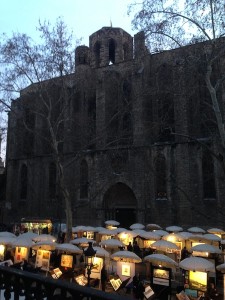
the view from our balcony in Barca
Our apartment was only minutes from the main cathedral so it was naturally the first major site we’d visited. Beautiful. Classic and traditional. Majestic. And more importantly, it served as the perfect benchmark to make comparisons with the Sagrada Familia. In other words, whilst both cathedrals can standalone in their own rights, both were also equally enriched by each other. It was a symbiotic relationship. (I would recommend that visitors see the traditional cathedral first as this would enhance their experience at the Gaudi cathedral.)

Barcelona Cathedral

Sagrada Familia
Barca was the perfect venue to re-introduce us to Spain. By the time we were on the RENFE train to Sevilla, we were completely relaxed and ready for more adventures.
[ CONFESSION: Based on my experiences with English trains, I had low expectations for the Spain trains. It was therefore a delight to find that the Spanish trains were clean and reliable and that the food (in particular, the toasted sandwiches) was actually quite delicious! ]
Train travel in Spain proved to be exceptionally easy. Prior to this trip, I’d researched the connections, timetables, etc. on an online site written by a train enthusiast (thank you Mark Smith — aka ‘The Man in Seat Sixty-One’) and used his recommendations to book the tickets online. As these were purchased in advance, they were cheaper than the daily rate travel. More importantly, it meant that we had guaranteed seats. In short, no stress whatsoever.
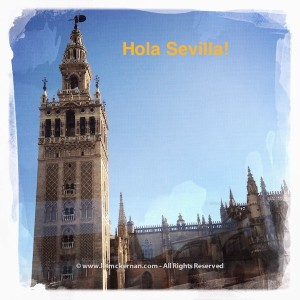
Once in Sevilla, we located our rented apartment and dropped off our bag. Our first priority was to locate el mercado – or, the local market. Even though we had maps and directions, we got lost. Frequently. Although Sevilla is often described as a “big small city”, or as a “small big city”, as an ancient city, Sevilla is crinkly and as such, it was difficult for us to get our bearings. In the end, I think it took us about 2 full days before we became comfortable enough to walk around without maps.
Our attempt to locate the market on the first day ended in failure. We therefore decided to eat out that night. Because most (non-tourist) restaurants in Sevilla do not start dinner service until 8PM, we had time to kill before dinner. We therefore decided to have a drink and walked into a tavern that had the most charm. Little did we know that we struck gold that night. The establishment that we’d stumbled upon was the oldest tavern in Sevilla (it was founded in 1670) and it oozed with a friendly old-world atmosphere. Real Iberian ham and sausages hung from the wall — these were not mere decorations — the waiters plucked the sausages from the wall and carved these to order. In addition, the tavern was full of locals whereby everyone seems to know each other. As I drank my Rioja and soaked in the lovely charm of the place, I decided then and there that I wanted to make this establishment “my local” whilst we were in Sevilla. Consequently, we visited this tavern every night that week. And each night, our experience at this tavern improved. I was genuinely sad to leave Sevilla because it meant that I was leaving this tavern. Our last night in Sevilla was celebrated with a beautiful Rioja, some great tapas, and a homemade flan that was simply the BEST flan I’ve ever had.

at El Rinconcillo, the oldest bar in Sevilla
As if finding this tavern by sheer blind good luck was not enough, we struck gold again a few nights later when at dinner we heard some commotion on the streets. It turned out that a nearby church was practicing their Semana Santa procession. I immediately jumped out of my seat (sorry Bruce!) and raced onto the street to record this short video. And I was doubly lucky because this video was recorded as the procession passed by the enchantedly beautiful Macarena.
My good luck with Semana Santa continued in Granada. In this instance, I wouldn’t described us as being ‘lost’ (because Granada was easily navigable compared to Sevilla) but we did managed to wander ‘off-plan’. During our aimless walkabout, we stumbled upon a church group that was taking their display out of storage. Never shy (especially when it pertained to photography) I got permission to photograph their Madonna. It was particularly special because I was able to get real close and I didn’t have to jostle with other tourists.
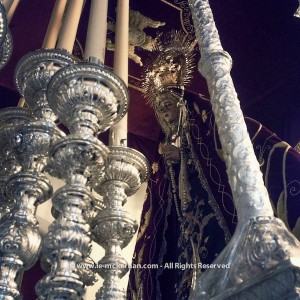
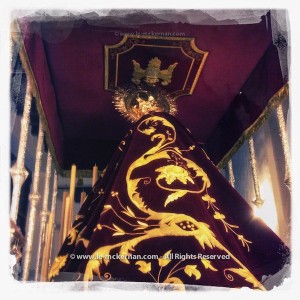
Later that week, we came across more practice processions. I’ve always known that these heavy displays needed many men to carry but it didn’t occur to me that a “medium” display would need as many as 35 men (as demonstrated in this video). It was insightful to see the men practice — not only were the men ‘beasts of burden’, but, they also had to walk in complete unison and march based on instructions barked out by their drill sergeant.
It was quite fortunate that we saw the practice session in Granada because it really made us appreciate how much effort and coordination were required. In the video below, you can see the Semana Santa team (in Cordoba) very skillfully navigate a narrow alleyway and then make an exceptionally tight corner turn. Remarkable!!!
The themes of good food (from Barcelona) and good luck (from Sevilla) continued as we moved onwards to Granada.
In my research for this trip, I had read that Alhambra has a daily limit on the number of visitors and therefore it was highly recommended to purchase tickets in advance. I assumed that this was only true during ‘peak seasons’ — i.e. during the summer months. But, I didn’t realise that the week prior to Holy Week was a high-demand time and when I went online to ‘browse’ for tickets, I was shocked to see that several of the dates were already sold out! We therefore booked our tickets quickly based on the dates that were still available. It transpired that we were lucky (again!) as the day we visited Alhambra was the only dry day of the week. For the rest of the week, it poured and poured and poured with rain.
[ A little digression here: technically, you don’t need tickets to visit Alhambra as there are some public spaces. But you do need tickets if you want to visit the towers or the palace or the famous landscaped gardens. In addition, you can visit Alhambra at night — this makes sense if you can’t get day tickets or the day temperature is too onerous. ]
In addition to purchasing day tickets, we also purchased night tickets because we thought that we would be able to see and to experience something special. To be completely honest, this was both a waste of time and money. Nothing was really open; the palace and the towers were locked. The tickets allowed us access to the landscaped garden but this wasn’t worth seeing at night. Plus, if we wanted to walk around Alhambra at night (minus the landscaped garden) then we could have entered the grounds without a ticket.
The obvious crowning jewel of Granada was the Alhambra; the other crown jewel was less obvious — ‘Los Diamantes’ was a modern bar in the centre of town that served some of the yummiest tapas we’ve had in Spain. I particularly recommend the fried baby squid and aubergine chips (with honey). [ From the street view, Los Diamantes looked like a tourist trap but surprisingly it was almost always full of locals — a very clear sign to us that this was worth a try! ] Although we’ve eaten at Los Diamantes several times during our short stay, we also took the opportunity to cook for ourselves and to buy fresh produce from the local markets. It was a delight (and quite a surprise) to find Rioja wines that normally costed us about EUR 80 to buy in Hong Kong on sale at the corner market for about EUR 8! Needless to say, we’d happily enjoyed knocking back a few bottles of our favourite brands.
Onwards to Cordoba . . . .
As much as we’d enjoyed Barcelona, Seville and Granada, it was time to hop back onto the train and head to our raison d’être. I’d timed the trip so that we would have a few days to explore Cordoba before the start of the festival. In hindsight, this was a very wise decision because it gave us the opportunity to map out the backstreets and passages which meant that if we needed to bypass or avoid a festival procession en-route, we could easily do so.
Succinctly, the Santa Semana surpassed all of my expectations. This was largely due to the fact that our wonderful AirBnB host managed to secure for us highly coveted tickets for front row seats along the main procession route. This enabled us to watch and to experience the processions unencumbered. It also meant that we were able to get great images without having to shoot over someone’s shoulders. But, in truth, I liked the fact that we experienced the festivals from both these seats as well as from the streets; in many ways, the atmosphere from the street was so very different from that from the procession seats that it often felt that we were experiencing two very different events.
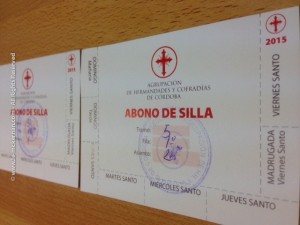
An unforgettable highlight of the festival was the 2AM procession. This procession was vastly different from the others — it was very sombre; there were no marching bands or musicians and some of the penitents walked the entire route barefooted. I had thought that this procession would have been lightly attended given the lateness of the march but I was woefully wrong. There were several hundreds lined along the procession route as the penitents slowly meandered thru the back streets of Cordoba to the Mezquita.
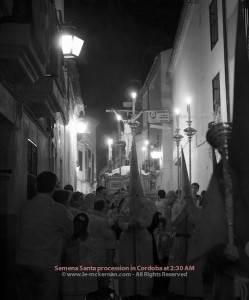
Our evenings were spent watching (or chasing) the processions. Our days were spent exploring the city, eating well and/or simply relaxing. Our rented apartment was only 2 blocks away from the Mezquita and as such, we took advantage of this proximity by exploring this iconic building multiple times in the morning. (Entry is free before 10AM; moreover, groups are banned from the morning entry — a very welcomed banned!) In hindsight, this was a smart move because it was easy to become overwhelmed by the majesty of the building at first sight. By our second and third visit, I found that I was more discriminatory in the types of images I was photographing. During our fourth and last visit, I actually spent more time with my camera in my bag as it was important to ‘drink in the experiences with my eyes and not with my camera’.
The Mezquita is a truly impressive building. (The only other building that I have found to be more impressive is the Haghia Sophia in Instanbul.) As such, I would recommend a visit to Cordoba if not for the Santa Semana festival, then at least for a visit to the Mezquita. This is well worth the effort — even if Cordoba has an extremely unhelpful and disinterested tourist officer stationed at the Tourism Desk.
I would happily spend another month in Spain again . . . .

Happy Travels …. from Tram & Bruce
March 25, 2001 | Categories: Spain, travel blog | Tags: Alhambra, Barcelona, Cordoba, El Rinconcillo, Granada, Holy Week, Informacion Turistica, Mezquita, Santa Semana, Semana Santa, Sevilla, Seville, Spain, The Man in Seat Sixty-One, travel blog, Unhelpful Cordoba Tourist Officer | Comments Off on Travel Blog — a month in Spain . . . .
